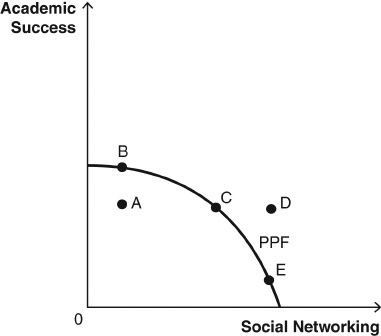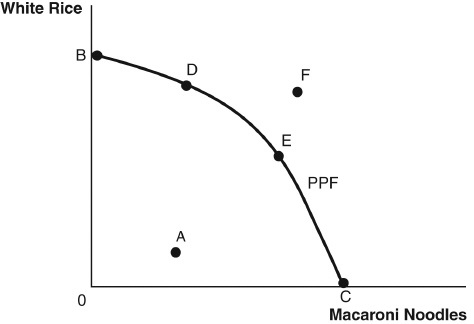Macroeconomics Final Exam Question Answers
Q1. When consumers discard their gasoline-powered automobiles for electric-powered ones, this partially reflects the ________ of gasoline.
- specialization
- incentive
- necessity
- scarcity
- luxury
Q2. A health insurance company may offer its policyholders a discount on their premiums if they prove that they have stopped smoking. What type of incentive is the health insurance company offering?
- complementary
- unintended
- indirect
- neutral
- direct
Q3. In the area of many college campuses, parking spaces are often scarce. If these parking spaces have parking meters, which population described below would pay for parking?
- those that are willing to take risks and believe that they will not be caught if they don’t place change in the meter
- those that are unwilling to take risks and believe there is a high chance that they will not be caught if they don’t pay for parking
- those that are unwilling to take risks, believe there is a high chance that they will be caught if they don’t pay for parking, and place a high value on doing the “right” thing
- those that are willing to take risks, believe that they will not be caught if they don’t place change in the meter, and disregard any possible $5 ticket for parking illegally
- those that place a high opportunity cost on making sure they have change and placing change in the meter
Q4. Kelly is an architect, and she is trying to decide whether to hire Lawrence, a draftsman, to assist with her work. Kelly could hire Lawrence at $20 per hour, but it would take him three times as long to complete a task as it takes Kelly. Kelly is able to earn $90 per hour and has more architectural jobs than she is able to handle. Which of the following is true?
- Lawrence should be hired, but only if he is paid more than $30 per hour.
- Kelly should not hire Lawrence because it would be faster for her to do the work herself.
- Lawrence should be hired at the $20 per hour wage rate.
- Kelly should hire someone who earns minimum wage instead of Lawrence.
- Kelly should do the drafting work herself because she has the lower opportunity cost.
Q5. Nicole asked her neighbor to rake the leaves on his lawn because they were blowing into her yard. It takes an hour to rake the yard, regardless of who performs the task. He responded that it wouldn’t be rational for him to do so, but he would be willing to hire someone else to rake. Why would this be the case?
- Her neighbor lacks the equipment to rake leaves and thinks it would take too long to do the job.
- Her neighbor is getting revenge on her because Nicole didn’t rake the leaves on her lawn last year.
- Her neighbor is a busy person and doesn’t have time to rake leaves.
- Her neighbor is a lawyer who values his time at $200 an hour and knows that he can hire a high school kid to rake leaves for $20 an hour.
- Her neighbor is a high school teacher and values his time at $15 an hour, and he knows that he can hire one of his students to rake leaves for $20 an hour.
Q6. When Lucy chose a major, she likely thought about her skills. Let’s say Lucy doesn’t enjoy dealing with numbers. How could she explain to her parents, using logic from economics, why she chose to major in English instead of mathematics?
- The expected value of a major in English after graduation is low.
- The opportunity cost of going to college is too low.
- The opportunity cost of learning mathematics is too high.
- The opportunity cost of learning to appreciate literature is too high.
- The expected value of a major in mathematics after graduation is high.
Q7. The government has been considering doing away with minting pennies because they are rarely used for purchases (with most people collecting them or throwing them away). How would an economist best explain this consumer behavior?
- Prices have increased over time, and it would take far too many pennies to buy anything of value.
- More people are using credit and debit cards, so they are not in the habit of using monetary change.
- Prices have increased over time, and the opportunity cost of carrying around large quantities of pennies has become too large.
- Prices have increased over time, and the opportunity cost of carrying around pennies has fallen.
- People who use pennies probably aren’t spending enough money; removing the penny will force people to spend more.
Q8. Comparative advantage emerges because of the presence of
- scarcity.
- marginal benefits that equal marginal costs.
- differing opportunity costs.
- trade.
- incentives.
Q9. A recession has crippled the national economy, producing a high rate of unemployment. Which of the following would be a microeconomic decision?
- The United States negotiates a new trade agreement with Japan, hoping to bolster exports.
- Congress decides to institute a tax cut and encourage consumer spending.
- A Congresswoman decides to delay the purchase of a new car.
- The federal government extends the duration of unemployment benefits.
- The Federal Reserve lowers interest rates in an effort to stimulate business activity.
Q10. Why do incentives matter to economists?
- Governments are the source of all incentives and there is value in studying the actions of government.
- Incentives are often the guiding principle behind greed and exploitation.
- Without incentives, the distinction between microeconomics and macroeconomics would be unclear.
- Incentives explain how people make decisions, and are the key to understanding economics.
- People make poor decisions when they’re given money they didn’t earn.
Q11. Shoppers at supermarkets often abandon their empty shopping carts at various locations in the parking lot, despite the risk of damage to vehicles or the additional labor cost of retrieving those carts. How might an economist explain this behavior?
- Once a shopper leaves the parking lot, the abandoned cart becomes someone else’s problem.
- The perceived potential benefit of going to a cart return location is less than the time and energy cost to the shopper.
- People go to the supermarket when they have the energy to shop only, without considering the cost of returning their carts.
- Because food prices are always subsidized by the government, shoppers are ignorant of additional costs.
- People are generally lazy and gravitate toward any decision with the lowest cost.
Q12. If specialization and outsourcing can harm domestic workers, why do countries still engage in trade?
- Shipping companies have a powerful lobby in Congress.
- Most workers have little influence on politicians and are ignored.
- Domestic workers can move to a country with a greater need for their skills.
- Welfare programs can support unemployed workers.
- The gains from trade far outweigh the costs, and the economy benefits overall.
Q13. Wages are higher in Country X than in Country Y. If the countries decide to trade, then who will benefit?
- Only the country that can produce the product more efficiently will benefit.
- Both countries can benefit regardless of the products traded.
- Only the country that can produce the product at a lower opportunity cost will benefit.
- Neither country can benefit unless one knows the product that is traded.
- Both countries will benefit, but only if a trade agreement for specific products is made by their respective governments.
Q14. The scientific method and the tools of economics are useful in examining
- only the trade-offs evident in the production possibilities frontier (PPF).
- anything; economists will use their tools to study anything in the world around them.
- only how government policies affect macroeconomic outcomes.
- only how business firms make decisions.
- only how individuals make decisions.
Q15. When testing a model rocket on a campus quad, which of the following would be an endogenous factor?
- the size of the rocket engine
- the extent of precipitation
- the quad’s elevation and air pressure
- the gravitational pull of Earth
- the current wind speed across the quad
Q16. A society that is producing its maximum combination of goods and using all available resources for production
- has maximized its opportunity cost.
- has eliminated scarcity.
- has minimized its opportunity cost.
- is operating outside its PPF.
- is operating on its production possibilities frontier (PPF).
Q17. Refer to the accompanying figure to answer the following questions.

How is opportunity cost illustrated?
- a move from point B to point C
- a move from point C to point D
- a move from point D to point E
- a move from point A to point C
- a move from point A to point B
Q18. As we move from one efficient point on the production possibilities frontier (PPF) to another efficient point on the PPF, we experience
- unlimited resources.
- macroeconomics.
- opportunity cost.
- decreasing relative cost.
- unattainable combinations.
Q19. Mikhail and Stefan are both artists who can create sculptures or paintings each day. The following table describes their maximum outputs per day. Use this table to answer the following questions.
| Sculptures | Paintings | |
| Mikhail | 10 | 5 |
| Stefan | 6 | 2 |
Based on the table, does Mikhail or Stefan have an absolute advantage?
- No, neither has an absolute advantage.
- Yes, Mikhail has an absolute advantage in paintings, and Stefan has an absolute advantage in sculptures.
- Yes, Mikhail has an absolute advantage in sculptures, and Stefan has an absolute advantage in paintings.
- Yes, Stefan has an absolute advantage in both sculptures and paintings.
- Yes, Mikhail has an absolute advantage in both sculptures and paintings.
Q20. Refer to the following figure to answer the following questions.

What is the most preferred consumption point for a carbohydrate-loving society?
- point B
- point D
- point E
- point C
- point F
